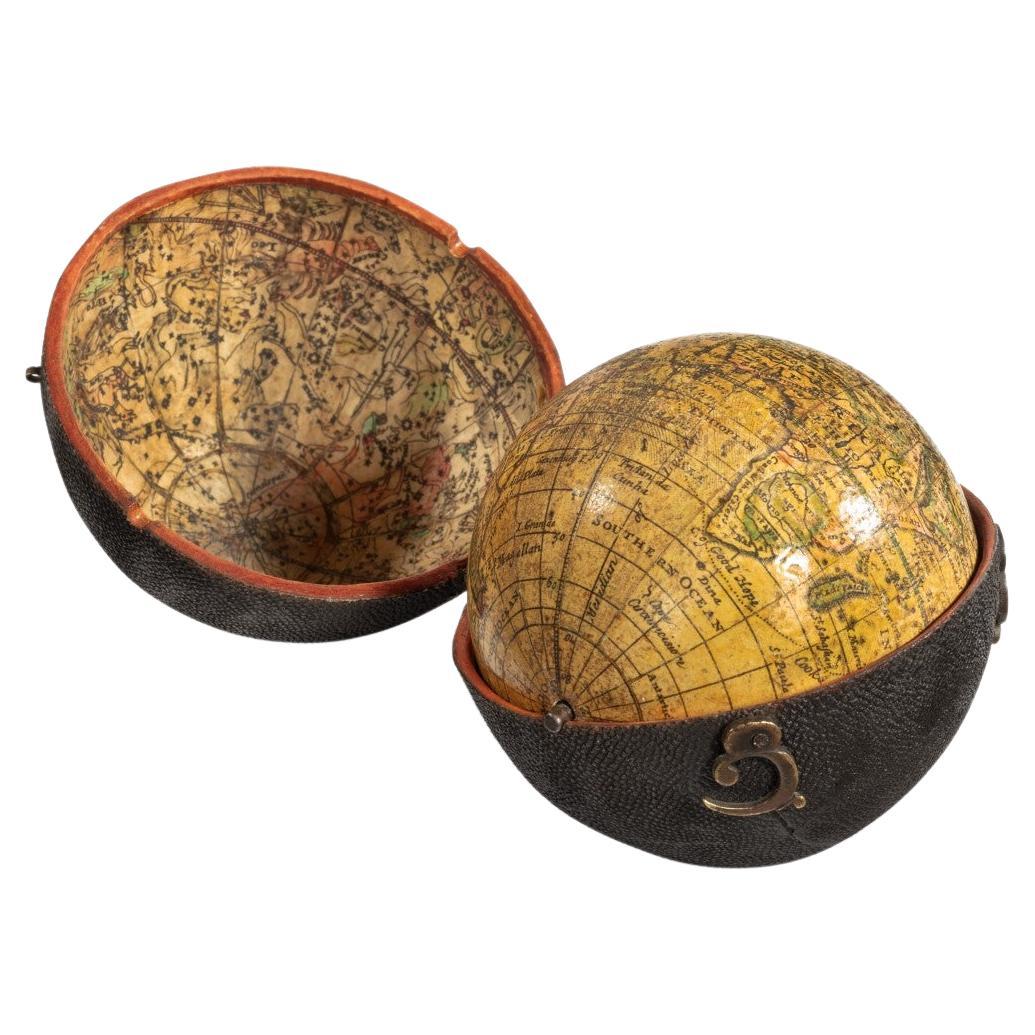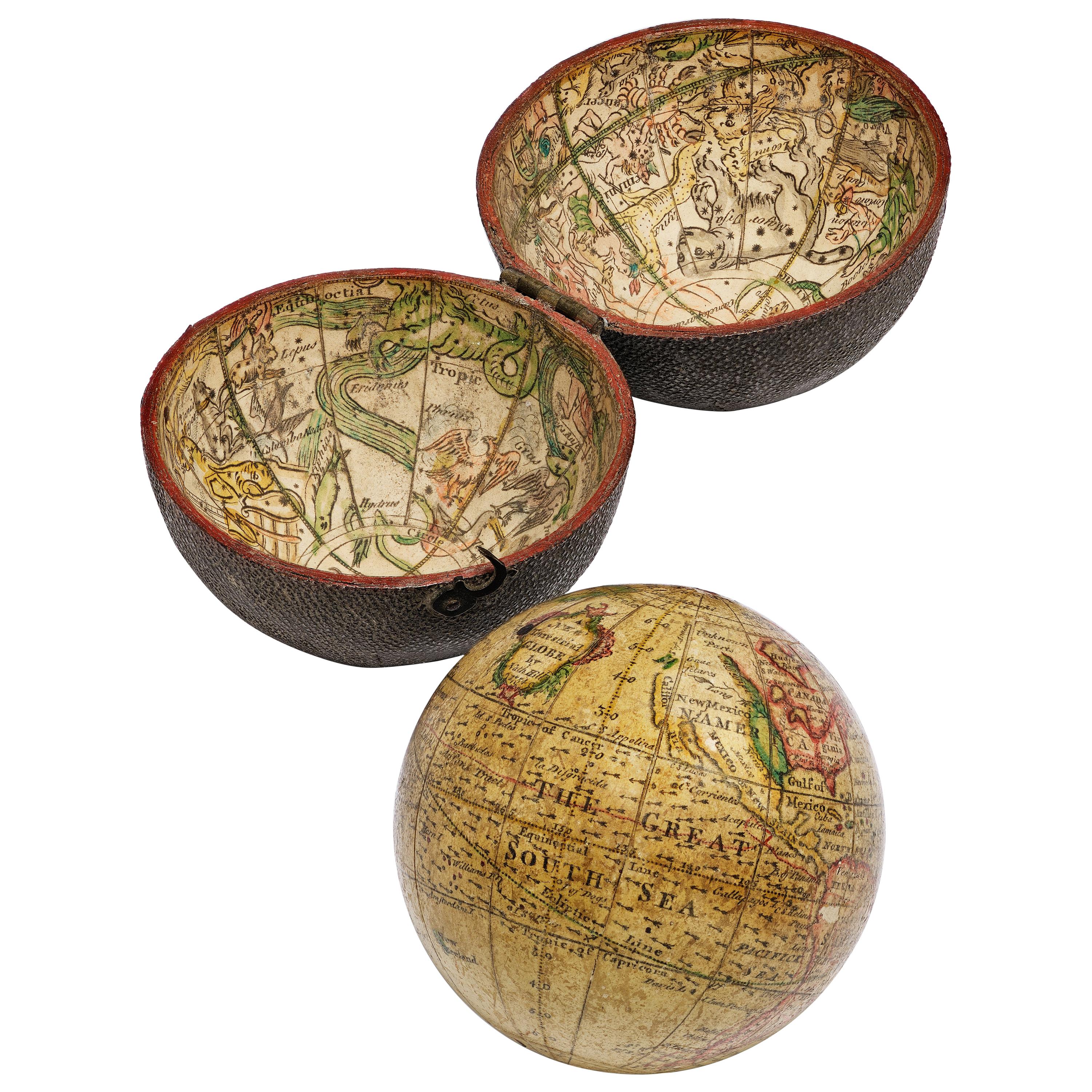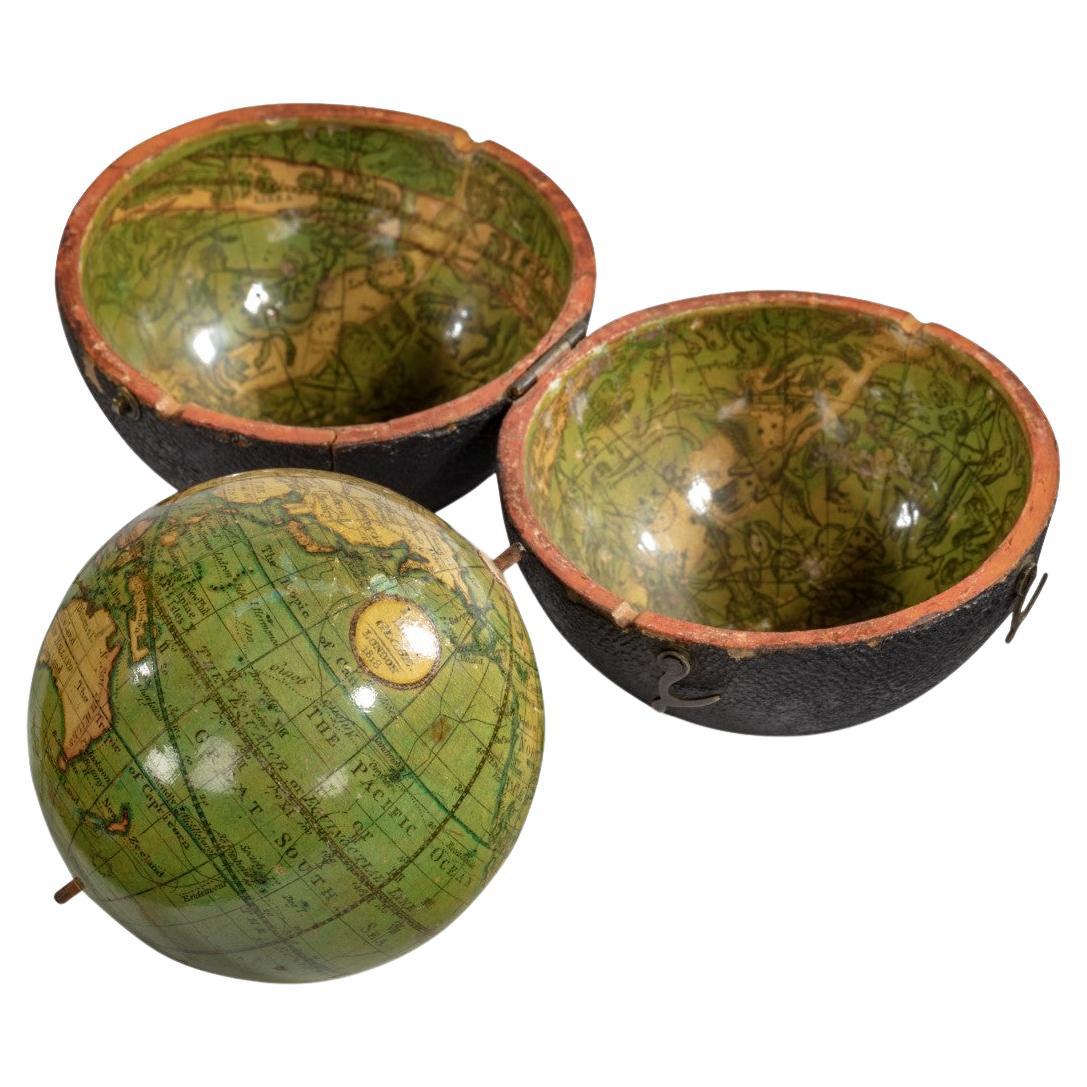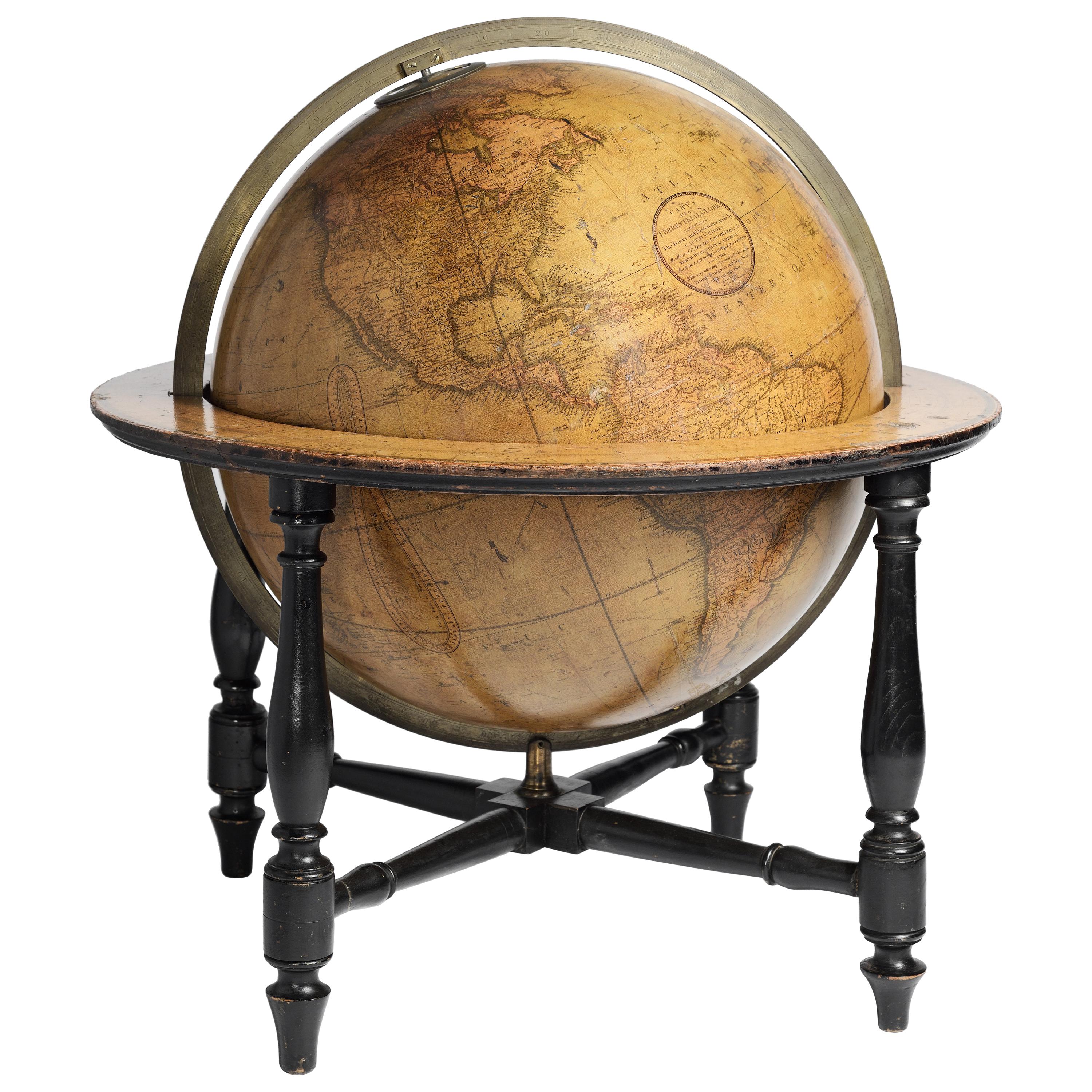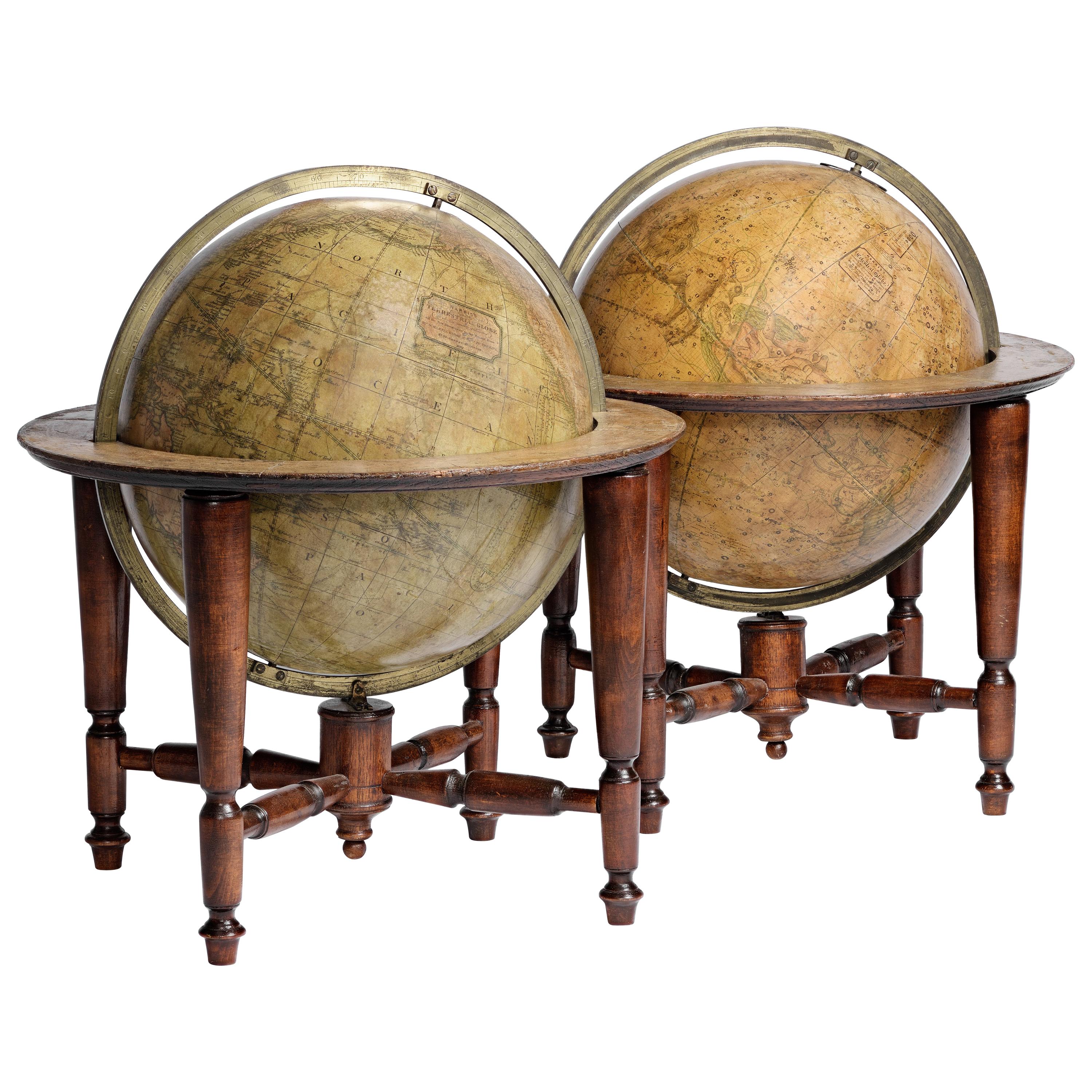Items Similar to English Pocket Globe, London, Circa 1775-1798
Video Loading
Want more images or videos?
Request additional images or videos from the seller
1 of 19
English Pocket Globe, London, Circa 1775-1798
About the Item
Pocket globe
London, between 1775 and 1798
Re-edition of the globe of Hermann Moll (1678-1732) dated 1719
The globe is contained in its original case, which itself is covered in shark skin.
There are slight gaps in the original paint on the sphere. The case no longer closes.
The sphere measures 2.7 in (7 cm) in diameter whereas the case measures 2.9 in (7.4 cm) in diameter.
lb 0.22 (kg 0.1)
The globe is made up of twelve printed paper gores aligned and glued to the sphere.
In the North Pacific Ocean there is a cartouche with the inscription:
A Correct
Globe
with the new
Discoveries.
The celestial globe is depicted on the inside of the box and is divided into two hemispheres with the cartouche:
A correct globe
with ye new cons
relations of Dr.
Halley & c.
It shows the ecliptic divided into the days of the zodiacal calendar and the constellations represented as animals and mythological figures.
On the globe are delineated the equinoctial line, divided by degrees and hours, the ecliptic and the meridian (passing west of Greenwich). The continents are shaded and outlined in pink, green and yellow. It shows: the Cook routes; a wind rose in the Southern Indian Ocean; Antarctica without land; Africa with Negroland (Hermann Moll is considered the first geographer to name the West African region in his 1727 map. (Encyclopaedia Britannica, ed. 1902, under "States of Central Africa"); Tartary in Central Asia; the Mogul kingdom in northern India; in North America only New England, Virginia, Carolina, Florida, Mississippi are identified; California is already a peninsula; the northwest coast of America is "unknown parts" (Alaska is not described and it is only partially delineated, it was to become part of the United States in 1867); Mexico is named "Spain"; Central South America "Amazone America". Australia (which was to be so named after 1829) is called New Holland. The route of Admiral Anson is traced (1740) and the trade winds are indicated by arrows. (See Van der Krogt, P., Old Globes in the Netherlands, Utrecht 1984, p. 146 and Van der Krogt, P. - Dekker, E., Globes from the Western World, London 1993, pp. 115.)
Elly Dekker, comparing Moll’s 1719 globe and his re-edition (of which the one described above is a sample), identifies the differences between them: the two editions are quite similar to each other, but in the "anonymous" globe, compared to the previous globe of 1719, California looks like a proper peninsula - the reports of the Spanish explorers of the region had given rise to uncertainty over whether it was connected to the mainland or not. The geographical nature of California was confirmed after the explorations of Juan Bautista de Anza (1774-1776). The routes of Dampier's journey were partially erased and the route of Captain James Cook's first voyage was superimposed on them, and the geography of Australasia was adapted accordingly, including the denomination of the Cook Strait. See Dekker, Elly, Globes at Greenwich, 1999.
An important ante quem element is represented by Tasmania: it is not separated from Australia by the Bass Strait, which was discovered by Matthew Flinders in 1798.
For a comparison with other specimens see Van der Krogt, P., ibidem and Van der Krogt, P. - Dekker, E., ibidem.
- Creator:Herman Moll (Author)
- Dimensions:Height: 2.92 in (7.4 cm)Diameter: 2.92 in (7.4 cm)
- Style:George III (Of the Period)
- Materials and Techniques:
- Place of Origin:
- Period:
- Date of Manufacture:circa 1775-1798
- Condition:Wear consistent with age and use. There are slight gaps in the original paint on the sphere. The case no longer closes.
- Seller Location:Milano, IT
- Reference Number:1stDibs: LU4352213667112
About the Seller
4.3
Vetted Seller
These experienced sellers undergo a comprehensive evaluation by our team of in-house experts.
Established in 1860
1stDibs seller since 2018
19 sales on 1stDibs
Typical response time: 6 hours
Associations
International Confederation of Art and Antique Dealers' Associations
- ShippingRetrieving quote...Ships From: Milano, Italy
- Return PolicyA return for this item may be initiated within 14 days of delivery.
More From This SellerView All
- Pair of English Globes by Cary, London, 1798 and 1800By Cary’sLocated in Milano, ITPair of 12-inch table globes John and William Cary London, 1798 and 1800 Some restored cracks and abrasions lb 11 each (kg 5) The two terrestrial and celestial globes rest in their original Dutch style stands with four supporting turned wood columns. Each one measures 18 in in height x 17 in in diameter with the diameter of the spheres measuring about 12 in; 46 cm in height x 43 cm in diameter x 31 cm diameter of the spheres. The 12 inch measure was one of the most frequently used by British manufacturers of globes of this period. Each globe is composed of two series of twelve printed paper gores, aligned and glued onto plaster spheres. The brass circle of the meridian bears engravings...Category
Antique Late 18th Century English George III Globes
MaterialsWood, Paper
- Pocket Globe by Nathaniel Hill, London 1754Located in Milano, ITNathaniel Hill Pocket globe London, 1754 The globe is contained in its original case, which itself is covered in shark skin. There are slight gaps in the original paint on the sphere. The case no longer closes. The sphere measures 2.6 in (6.8 cm) in diameter whereas the case measures 2.9 in (7.4 cm) in diameter. lb 0.24 (kg 0.11) The globe is made up of twelve printed paper gores aligned and glued to the sphere. In the North Pacific Ocean there is a scroll with the inscription: A New terrestrial Globe by Nath. Hill, 1754. The celestial globe is depicted on the inside of the box. On the terrestrial globe much of central and southern Africa is empty. North America bears only the name of some British colonies. It shows California as a peninsula and the northwest coast of America as "unknown parts" (Alaska is not described and is only partially delineated; it would become part of the United States in 1867). The route of Admiral Anson is traced (1740) and the trade winds are indicated by arrows. Australia, still named New Holland (the new name would be introduced in 1829), is part of the west coast. (See Van der Krogt, P., Old Globes in the Netherlands, Utrecht 1984, p. 146 and Van der Krogt, P. - Dekker, E., Globes from the Western World, London 1993, p. 115.) Nathaniel Hill (London, news from 1746 to 1768) had impeccable professional credentials: he had done his apprenticeship with Richard Cushee, who at the time was carrying out surveying work for John Senex's Surrey map...Category
Antique 1750s English George II Globes
MaterialsShagreen, Paper
- 18-inch Globe, Cary's, London, 1840By Cary’sLocated in Milano, ITJohn and William Cary Updated by George and John Cary Terrestrial Globe London, 1840 lb 22 (kg 10) Slight surface abrasions due to use. A small crack on the horizon circle. The globe rests in its original Dutch style stand with four supporting turned wood columns. It measures 26 in in height x 23.6 in in diameter with the diameter of the sphere measuring 18 in; 66 cm in height x 60 cm in diameter with the diameter of the sphere measuring 45.72 cm. The 18 inch...Category
Antique 1840s English Early Victorian Globes
MaterialsWood, Paper
- Pair of English 12-inch Globes by William Harris, London, 1832 and 1835By William HarrisLocated in Milano, ITPair of 12-inch table globes William Harris London, 1832 and 1835 Slight abrasions from use; few cracks lb 11 each (kg 5) The two terrestrial and celestial globes rest in their original Dutch style stands with four supporting turned wood columns. Each one measures 12 in in height x 16.5 in in diameter with the diameter of the spheres measuring approximately 12 in; 48 cm in height x 42 cm in diameter x 31 cm diameter of the spheres. The 12 inch measure was the most frequently used by British manufacturers of globes of this period. Each globe is composed of two series of twelve printed paper gores, aligned and glued onto plaster spheres. The brass circle of the meridian bears engravings...Category
Antique 1830s English William IV Globes
MaterialsPaper, Wood
- Pocket Globe, Nicholas Lane, London, post 1779By Nicholas LaneLocated in Milano, ITPocket Globe Nicholas Lane London, post 1779 The globe is contained in its original case, which is covered in leather. The sphere measures 2.75 in (6.9 cm) whereas the case measure...Category
Antique 1780s English Other Models and Miniatures
MaterialsLeather, Wood, Paper
- Miniature Terrestrial Globe Newton & Son London, Post 1833, Ante 1858By Newton and SonLocated in Milano, ITMiniature Terrestrial Globe Newton & Son London, post 1833, ante 1858 Paper, papier-mâché, bronze and wood It measures: sphere diameter 2.95 in (7.6 cm); diameter of the wooden base 6.02 in (15.3 cm); height 8.36 in (21.24 cm). Weight: 2,067 lb. State of conservation: the globe still bears its original paint, but has various small gaps, abrasions and stains on the surface. The globe is hinged with two pins at the meridian circle, which is in turn inserted perpendicular to the horizon circle; this is supported by four semi-arches connected at the bottom by a small goblet-shaped foot, resting on a wooden bell-shaped base. Apart from the wooden base, the entire support structure is made of bronze; on the foot there are the scale reproductions of a compass, a telescope and an open book. The sphere is made of papier-mâché and is covered with twelve printed paper gores. In the North Pacific Ocean the globe bears a cartouche with the inscription (about 30% of the writing is illegible, but the missing parts can be easily integrated based on the rest): NEWTON’S New & Improved TERRESTRIAL Globe Published by Newton & Son 66 Chancery Lane LONDON On the globe, much of central Africa is empty and the great lakes Tanganyika and Victoria are not marked (Europeans would begin to explore the area after 1858). Canada is called "British Territory" and Alaska "Russian Territory" (it would become part of the United States in 1867). Australia already bears its modern name (until 1829 it had been called New Holland) and its coasts are completely designed; Tasmania is listed as an island (Matthew Flinders circumnavigated it in 1798). The routes of Cook's various voyages are plotted; both the route followed by Biscoe in 1831 and the "Land of Enderby" which he discovered on the coast of Antarctica, south of Africa, are marked. Bibliography P. Van der Krogt, Old Globes...Category
Antique 1840s English Early Victorian Maps
MaterialsBronze
You May Also Like
- George III Pocket Globe After Herman MollBy Herman MollLocated in Lymington, HampshireA 3 inch George III pocket globe after Herman Moll, the terrestrial globe inscribed in a cartouche ‘A correct globe with the new discoveries’ and fitted within a hinged black shagreen case, the concave interior of the case applied with the engraved celestial charts...Category
Antique 1770s English George III Globes
MaterialsWood
- Regency Lane’s Pocket Globe, Dated 1818By Lane'sLocated in Lymington, HampshireA 3 ½ inch Regency Lane’s pocket globe, dated 1818, the terrestrial globe with the seas in light green and the land masses outlined in darker green, contained within a hinged black shagreen case, the concave interior of the case applied with the engraved celestial charts...Category
Antique 1810s English Regency Globes
MaterialsWood
- 19th Century German Miniature Pocket Terrestrial GlobeBy C. Abel-KlingerLocated in Essex, MAA miniature 19th century 3.5 inch diameter pocket terrestrial globe by C. Abel-Klinger, Nuremberg, Germany, in English for the English speaking markets. Signed with cartouche reading...Category
Antique 1880s German Scientific Instruments
MaterialsBrass
- English Camphor Wood Sea Captain's Chest with Braided Beckets, Circa 1770Located in Hollywood, SCEnglish Camphor wood sea captain's chest with hinged top, exposed corner dovetailing, original mounted braided beckets, and terminating on the original rectangular molded edge base....Category
Antique 1770s English George III Nautical Objects
MaterialsFruitwood, Rope
- Antique World Globe From Fleet Street London 1923 on Wooden StandLocated in High Wycombe, GBAntique Terrestrial Geographia of Fleet Street London 12"inch World Globe on handcrafted Wooden Three Legged Base 1923 Made 55 Fleet Street, London Beautiful desktop globe, sho...Category
Vintage 1920s British Art Deco Globes
MaterialsWood, Paper
- Pair of Philip & Son Globes, circa 1946By George Philip & SonLocated in London, GBA wonderful set of Terrestrial and Celestial 12 inch globes by George Philip and Son. Presented on brass inclined plain mounts attached to original turned ebonized wooden bases and uprights with axes secured at the top by brass acorn finials. Unusually, the terrestrial globe has a copyright date shown under the cartouche, 1946. The celestial globe is printed in beige against a dark blue background and shows the constellations and many named stars. Solid lines connect the stars within constellations rather than illustrating them as mythological and other figures.? A cartouche is present that includes the title and maker's address. When looking at the stars from Earth the viewpoint is effectively inside a celestial sphere. The surface of a celestial globe shows the star field as a projection viewed from the outside and is therefore reversed, with the constellations appearing as their mirror images. The terrestrial globe is printed in several colours and comprises of twelve coated lithographic paper gores with polar calottes over a twelve inch card sphere. The age of the globe has been confirmed by the political borders and named cities displayed. The globe is nicely detailed and has a grid network of parallels and meridians. It shows all the continents and countries as they were at the time it was printed and also indicates all the principal steamship routes with distances in nautical miles. The globe also has a printed Analemma - a diagram showing the declination of the Sun for every day in the year and the equation of time. The Analemma therefore shows the position of the Sun in the sky as seen from a fixed location on Earth at the same mean solar time, as the sun's position varies over the course of a year. A cartouche is present that includes the title and maker's address. Dimensions of each globe: 30.5 cm/12 inches (diameter) x 59 cm/23 1/4 inches (max height). George Philip, (1800–1882) was a cartographer and map publisher. He founded George Philip & Sons in 1834 in Liverpool primarily as a bookseller and stationer, but rapidly expanding to become a publisher of primarily maps, atlases and educational works. He had one son, also George (1823–1902), who was admitted to the business in 1848. George senior was born in Huntly, Aberdeenshire and by 1819 he had become assistant to the Liverpool bookseller, William Grapel before going on to start his own business. He used cartographers (such as John Bartholomew the elder, August Petermann, and William Hughes) to produce maps on copper plates. Philip then had these printed and hand-coloured by his women tinters. The business expanded rapidly and by the time he produced his county maps of 1862 he was using machine...Category
Vintage 1940s British Globes
MaterialsBrass

